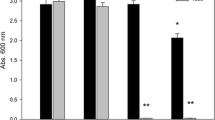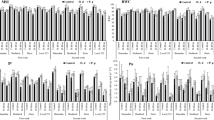Abstract
Although both sodium and chloride in high concentrations have toxic effects to plant growth, some plant species are more tolerant to Na+ stress than Cl− and vice versa. Until now, few studies compare the effects of separate and combined toxicities of Na+ and Cl− on nodulated leguminous plants. In this study, Na+-dominant, Cl−-dominant, and NaCl treatments were applied to two alfalfa cultivars with or without rhizobial inoculation. The results showed that high Na+ was more toxic than high Cl− to alfalfa growth. Shoot dry weight reduction was found in Na+ but not Cl−-dominant treatments, and the reduction in root dry weight was caused by the additive effect of Na+ and Cl− toxicities in uninoculated plants. Rhizobial inoculation significantly promoted plant growth by the improvement in both nitrogen nutrition status and root growth. At NaCl treatment, the promoted growth was also associated with the lower Cl− concentrations in the inoculated plants relative to the uninoculated plants. Additionally, rhizobial inoculation induced the differential expression of the salt-response genes, MsHSP81.2 and MsCLC1. In conclusion, the above results indicate that both Na+ and NaCl toxicities reduced alfalfa growth, and the reductions were greater under NaCl toxicity conditions and were mainly caused by the additive effects of Na+ and Cl− toxicities. Rhizobial symbiosis can alleviate separate and combined toxicities of Na+ and Cl− through enhanced nitrogen nutrition and root growth, the change of the accumulation and partitioning of K+ and Cl−, and accordingly the differential expression of some salt-response genes. The above results offer an economical measure in the future application of biofertilizers for alfalfa salt tolerance.







Similar content being viewed by others
References
Ahmad M, Zahir ZA, Asghar HN, Arshad M (2012) The combined application of rhizobial strains and plant growth promoting rhizobacteria improves growth and productivity of mung bean (Vigna radiata L.) under salt-stressed conditions. Ann Microbiol 62:1321–1330
Almeida D, Oliveira M, Saibo N (2017) Regulation of Na+ and K+ homeostasis in plants: towards improved salt stress tolerance in crop plants. Genet Mol Biol 40:326–345
Ashrafi E, Zahedi M, Razmjoo J (2014) Co-inoculations of arbuscular mycorrhizal fungi and rhizobia under salinity in alfalfa. Soil Sci Plant Nutr 60:619–629
Aydi S, Sassi S, Abdelly C (2008) Growth, nitrogen fixation and ion distribution in Medicago truncatula subjected to salt stress. Plant Soil 312:59–67
Bertrand A, Dhont C, Bipfubusa M, Chalifour FP, Drouin P, Beauchamp CJ (2015) Improving salt stress responses of the symbiosis in alfalfa using salt-tolerant cultivar and rhizobial strain. Appl Soil Ecol 87:108–117
Bouizgarne B, Oufdou K, Ouhdouch Y (2015) Actinorhizal and rhizobial-legume symbioses for alleviation of abiotic stresses. In: Arora NK (ed) Plant microbes symbiosis: applied facets. Springer, New Delhi, pp 273–295
Brownlee C (2018) Plant physiology: one way to dump salt. Curr Biol 28:R1145–R1147
Cui G, Ai S, Chen K, Wang X (2019) Arbuscular mycorrhiza augments cadmium tolerance in soybean by altering accumulation and partitioning of nutrient elements, and related gene expression. Ecotoxicol Environ Saf 171:231–239
Deinlein U, Stephan AB, Horie T, Luo W, Xu G, Schroeder JI (2014) Plant salt-tolerance mechanisms. Trends Plant Sci 19:371–379
El-Akhal M, Rincón A, Coba de la Peña T, Lucas MM, El Mourabit N, Barrijal S, Pueyo JJ (2013) Effects of salt stress and rhizobial inoculation on growth and nitrogen fixation of three peanut cultivars. Plant Biol 15:415–421
Franzisky B, Geilfus C, Kränzlein M, Zhang X, Zörb C (2019) Shoot chloride translocation as a determinant for NaCl tolerance in Vicia faba L. J Plant Physiol 236:23–33
Genc Y, Oldach K, Taylor J, Lyons GH (2016) Uncoupling of sodium and chloride to assist breeding for salinity tolerance in crops. New Phytol 210:145–156
Grattan SR, Grieve CM (1999) Salinity–mineral nutrient relations in horticultural crops. Sci Hortic (Amsterdam) 78:127–157
Kotula L, Clode P, Jimenez J, Colmer T (2019) Salinity tolerance in chickpea is associated with the ability to ‘exclude’ Na from leaf mesophyll cells. J Exp Bot 70:4991–5002
Kumar A, Dames JF, Gupta A, Sharma S, Gilbert JA, Ahmad P (2015) Current developments in arbuscular mycorrhizal fungi research and its role in salinity stress alleviation: a biotechnological perspective. Crit Rev Biotechnol 35:461–474
Li B, Tester M, Gilliham M (2017) Chloride on the move. Trends Plant Sci 22:236–248
Li CC, Zhou J, Wang X, Liao H (2019) A purple acid phosphatase, GmPAP33, participates in arbuscule degeneration during arbuscular mycorrhizal symbiosis in soybean. Plant Cell Environ 42:2015–2027
Liu M, Wang TZ, Zhang WH (2015) Sodium extrusion associated with enhanced expression of SOS1 underlies different salt tolerance between Medicago falcata and Medicago truncatula seedlings. Environ Exp Bot 110:46–55
Ma X (2012) Diversity and applied basis of rhizobia isolated from Medicago sativa in Xinjiang. Master thesis, Xinjiang Agricultural University, China
Martínez R, Espejo A, Sierra M, Ortiz-Bernad I, Correa D, Bedmar E, López-Jurado M, Porres JM (2015) Co-inoculation of Halomonas maura and Ensifer meliloti to improve alfalfa yield in saline soils. Appl Soil Ecol 87:81–86
Matheson SL, Nowak J, MacLean NL (1990) Selection of regenerative genotypes from highly productive cultivars of alfalfa. Euphytica 45:105–112
Mian A, Oomen RJ, Isayenkov S, Sentenac H, Maathuis FJ, Véry AA (2011) Over-expression of an Na+ and K+ permeable HKT transporter in barley improves salt tolerance. Plant J 68:468–479
Munns R, Tester M (2008) Mechanisms of salinity tolerance. Annu Rev Plant Biol 59:651–681
Negrão S, Schmöckel SM, Tester M (2017) Evaluating physiological responses of plants to salinity stress. Ann Bot 119:1–11
Qadir M, Noble AD, Chartres C (2013) Adapting to climate change by improving water productivity of soils in dry areas. Land Degrad Dev 24:12–21
Qu L, Huang Y, Zhu C, Zeng H, Shen C, Liu C, Zhao Y, Pi E (2016) Rhizobia-inoculation enhances the soybean’s tolerance to salt stress. Plant Soil 400:209–222
Rahnama A, Munns R, Poustini K, Watt M (2011) A screening method to identify genetic variation in root growth response to a salinity gradient. J Exp Bot 62:69–77
Rubio F, Gassmann W, Schroeder JI (1995) Sodium-driven potassium uptake by the plant potassium transporter HKT1 and mutations conferring salt tolerance. Science 270:1660–1663
Ruibal C, Castro A, Carballo V, Szabados L, Vidal S (2013) Recovery from heat, salt and osmotic stress in Physcomitrella patens requires a functional small heat shock protein PpHsp16.4. BMC Plant Biol 13:174
Sandhu D, Cornacchione MV, Ferreira JF, Suarez DL (2017) Variable salinity responses of 12 alfalfa genotypes and comparative expression analyses of salt-response genes. Sci Rep 7:42958
Shelden M, Roessner U, Sharp R, Tester M, Bacic A (2013) Genetic variation in the root growth response of barley genotypes to salinity stress. Funct Plant Biol 40:516–530
Sheng LC (2016) Genotypic difference of salt tolerance and the effect of rhizobium inoculation in alfalfa. Master thesis, Xinjiang Agricultural University, China
Singh K, Trivedi P, Singh G, Singh B, Patra DD (2016) Effect of different leaf litters on carbon, nitrogen and microbial activities of sodic soils. Land Degrad Dev 27:1215–1226
Sun J, Dai S, Wang R, Chen S, Li N, Zhou X, Lu C, Shen X, Zheng X, Hu Z, Zhang Z, Song J, Xu Y (2009) Calcium mediates root K+/Na+ homeostasis in poplar species differing in salt tolerance. Tree Physiol 29:1175–1186
Tavakkoli E, Fatehi F, Coventry S, Rengasamy P, McDonald GK (2011) Additive effects of Na+ and Cl− ions on barley growth under salinity stress. J Exp Bot 62:2189–2203
Tavakkoli E, Rengasamy P, Mcdonald GK (2010) High concentrations of Na+ and Cl− ions in soil solution have simultaneous detrimental effects on growth of faba bean under salinity stress. J Exp Bot 61:4449–4459
Tavakkol E, Rengasamy P, McDonald GK (2010) The response of barley to salinity stress differs between hydroponic and soil systems. Funct Plant Biol 37:621–633
Teakle NL, Tyerman SD (2010) Mechanisms of Cl− transport contributing to salt tolerance. Plant Cell Environ 33:566–589
Timperio AM, Egidi MG, Zolla L (2008) Proteomics applied on plant abiotic stresses: role of heat shock proteins (HSP). J Proteom 71:391–411
Wang G, Sheng L, Zhao D, Sheng J, Wang X, Liao H (2016) Allocation of nitrogen and carbon is regulated by nodulation and mycorrhizal networks in soybean/maize intercropping system. Front Plant Sci 7:1901
Wang M, Zheng Q, Shen Q, Guo S (2013) The critical role of potassium in plant stress response. Int J Mol Sci 14:7370–7390
Wang W, Vinocur B, Shoseyov O, Altman A (2004) Role of plant heat-shock proteins and molecular chaperones in the abiotic stress response. Trends Plant Sci 9:244–252
Wang Y, Zhang Z, Zhang P, Cao Y, Hu T, Yang P (2016) Rhizobium symbiosis contribution to short-term salt stress tolerance in alfalfa (Medicago sativa L.). Plant Soil 402:247–261
Wu H, Zhu M, Shabala L, Zhou M, Shabala S (2015) K+ retention in leaf mesophyll, an overlooked component of salinity tolerance mechanism: a case study for barley. J Integr Plant Biol 57:171–185
Acknowledgements
We appreciate the financial support from the Key Realm R&D Program of Guangdong Province (2018B020205003).
Author information
Authors and Affiliations
Corresponding authors
Additional information
Communicated by Przemyslaw Wojtaszek.
Publisher's Note
Springer Nature remains neutral with regard to jurisdictional claims in published maps and institutional affiliations.
Electronic supplementary material
Below is the link to the electronic supplementary material.
Rights and permissions
About this article
Cite this article
Sheng, L., Cui, G., Luo, M. et al. Rhizobium inoculation alleviates separate and combined toxicities of Na+ and Cl– in alfalfa. Acta Physiol Plant 42, 177 (2020). https://doi.org/10.1007/s11738-020-03164-3
Received:
Revised:
Accepted:
Published:
DOI: https://doi.org/10.1007/s11738-020-03164-3




